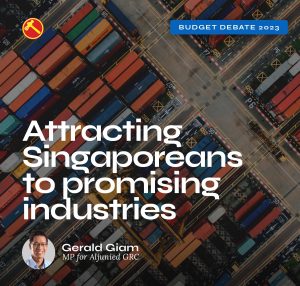Budget Debate 2024, 26 Feb 2024
Mr Speaker,
Fair competition
Singaporean workers aspire towards making a good living and engaging in meaningful work that uplifts not only their own families, but also their communities, their nation and the world. One inescapable reality of work is competition.
We have always had a very competitive culture in Singapore. This has served us well in many ways, from the excellent performance of our students in schools to our efforts to top the global rankings in everything from corruption perceptions to business friendliness.
However, competition also has a darker side. Singaporeans are not looking to the government to shield them from global competition at the workplace. However, we detest unfair competition, where people who do not play by the rules or follow local norms still get ahead.
For example, when Singaporean workers see colleagues getting hired and promoted not on the basis of their ability and hard work, but because their manager prefers working with people who share his cultural background, this creates a profound dissonance in them. Why? Because Singaporeans have been brought up to believe in meritocracy as a guiding principle in our society.
We want a Singapore which rewards workers and professionals based on their competence and hard work, not connections or tribal loyalties.
Nevertheless, while we strive to shape the Singapore that we desire, we are but a small drop in a vast ocean. We have to teach our children and students to deal with the world as it is, not how they want it to be. They must be taught at home and in schools to speak up when they have something to contribute, and not keep silent in the background. They must be encouraged to ask for what is due to them, and not simply accept what others decide for them without question. And they must be willing to network with a wide spectrum of people from different cultures and nationalities, and understand what motivates them.
Singapore is often viewed as a nation of excellence. In local parlance, we do things “swee swee”. Give a Singaporean a task, and when they say they’ve done it, we can trust that it’s been done well. We must never let this culture of excellence slip. It is our advantage in an increasingly competitive world.
Boosting productivity
Artificial intelligence (AI) and robotics have both burst into mainstream consciousness in recent years, with the launch of generative AI and self-driving cars. These technologies could provide a path to boosting Singapore’s productivity by enhancing the speed, accuracy and efficiency of various tasks and processes.
There are many studies of AI’s measurable impact on productivity. For example, a joint-study by BCG and Harvard found that consultants using GPT-4 completed 12% more business tasks, 25% more quickly, with 40% higher quality, than a control group without AI access.
These are amazing opportunities for Singapore to take advantage of. The government can spur a broader uptake of AI and robotics not only for our scientists and businesses, but also for general purpose use by ordinary citizens.
In November 2023, I asked about whether the government planned to develop indigenous capabilities in creating and deploying AI foundation models, including establishing a National Foundation Model Research Institute. In February 2024, I proposed the creation of a national AI healthcare foundation model, which can be used to predict and intervene in a broad spectrum of diseases. I would like to repeat these calls here.
These are not just national initiatives, but possible precursors to greater regional scientific co-operation. Singapore needs the right institutions and opportunities, in order to attract and retain the best minds, including talented Singaporean scientists and entrepreneurs.
I am under no illusions about the potential of these new technologies to cause job losses. This is why in January 2024, I asked the government for its plans to proactively retrain workers who are at most risk of displacement from AI. We need interventions to steel our citizens against AI-driven job redundancy. It is better for us to be the architects of our own disruption, than to allow technology to change us for the worse.
It is tempting to pull out the old playbook of pouring money into training programmes and encouraging workers to attend courses. However, this approach may not succeed in upskilling an entire workforce in disruptive new technologies.
We must also embrace tacit learning through the hands-on use of AI and robotics. Tacit learning is learning by doing.
Using AI tools or robots needs to be made as easy and as commonplace as googling for answers on a web browser or operating a TV remote control. Robots should be deployed more widely in our environment so that the public gets used to seeing and using them every day. Giving every Singaporean hands-on practice with AI and robotics will better ensure that the gains from these technologies go to everyone — manual workers and knowledge workers, civil servants and entrepreneurs, MNCs and SMEs.
SkillsFuture must also support tacit learning. In February 2024 in my adjournment motion on global AI leadership, I called for the subscriptions to cutting-edge AI tools to be subsidised by SkillsFuture Credits. AI tools make workers more productive, and we should give our people more opportunities to use them.
We must strive for the whole breadth of Singapore society to have more contact with the best AI models and robots. Only by trying things out as a first mover, and being willing to accept and learn from failure, can we gain and retain the thousand points of knowledge that no instructor can teach.
New world order
In his Budget Statement, Deputy Prime Minister Lawrence Wong rightly pointed out that we are now in an era of armed conflict, confrontation and terrorism, with major powers prioritising national security over international cooperation, and that there is a diminished willingness to tackle global issues.
These are stark realities. We must work within the realities of this new world order, as the old order is probably not coming back anytime soon.
DPM Wong said that we will pursue better jobs and better growth. He made a commitment to improve wages across professions. In particular, he said that the wages and career prospects of ITE graduates should not be too far behind polytechnic and university graduates.
I fully support this. I hope the wages of skilled tradespersons will come much closer to par with knowledge workers, because of the value they bring to our economy and our society. I will elaborate further on this during the Committee of Supply debate on MOM’s budget.
The introduction of the SkillsFuture Level Up Programme, which injects another $4,000 into Singaporeans’ SkillsFuture Credit, is welcome. DPM Wong said it is to be used for selected training programmes with “better employability outcomes”, including part-time and full time diplomas and undergraduate programmes. In addition, workers 40 years old and above will have the opportunity to pursue another full time diploma at subsidised rates.
How did the government arrive at the conclusion that these diploma and degree programmes have better employability outcomes? Is there empirical evidence to support it? And if there is, are the better outcomes due to the greater skills that these graduates have acquired or because local employers continue to emphasise paper qualifications over skills and experience?
In fact, it has been recognised that one of the most effective ways to pick up employable skills is through on-the-job training (OJT) and apprenticeships. As such, I would suggest that the government subsidise OJT and apprenticeship programmes to the same tune as diploma and degree programmes.
In his Budget Statement, DPM Wong mentioned briefly about how the government will do more to support those whose jobs are made redundant through a temporary financial support scheme for the unemployed. He said the government will be working out the details later this year. Sir, this scheme was announced almost one year ago, at the National Day Rally in August last year. How much longer will it take to flesh out? More importantly, how fiscally sustainable will this scheme be?
Will it include an insurance component, like what the Workers’ Party has proposed through its Redundancy Insurance Scheme, to ensure that premium contributions from employers and employees during times of plenty can be drawn down during economic downturns when retrenchment levels are higher?
Cost burdens for disability community
Mr Speaker, social inclusion must be at the heart of all our economic policies. I am glad to note that the maximum monthly fees at Special Education (SPED) schools will be lowered to $90, with lower fee caps at all centres.
However, Singapore should move towards equalising the fees for SPED schools and mainstream schools. While I am aware that the cost for providing education at both types of schools is different, the school fees should be the same. So if mainstream primary school fees are only $13 a month, then SPED school fees should also be $13 a month, not $120, which is the current average. Even lowering it to $90, while commendable, is still not equitable. This is especially so considering the higher costs that parents of special needs children incur in many other areas besides education. The additional costs of SPED schools should be socialised in the interest of creating a more inclusive and equitable society.
School bus fares remain another significant concern for the disability community. As of 1 January 2024, the Ministry of Education (MOE) has increased the price cap of school bus fares for school bus operators at mainstream schools by up to 13%. But SPED school students face a higher increase in their school bus fares due to the smaller pool of bus operators who are able to meet their more complex needs.
I am aware and appreciate that there are various school bus subsidy assistance schemes like the MOE Financial Assistance Scheme (FAS) and the Enabling Transport Subsidy (ETS).
While I understand the need to keep the school bus operators sustainable, the adverse impact of the cost of living crisis has made the cost of school bus transport an added burden for many parents of students with disabilities. Many rely heavily on school bus transport to commute to and from home, school and social service agencies to attend programmes such as the Early Intervention Programme for Infants and Children (EIPIC), Day Activity Centres, Sheltered Workshops* and Special Student Care Centres. Very often there are additional costs involved. EIPIC, for example, is a half-day programme, so the students need to also be ferried from their school to the programme, creating a double whammy in transport costs.
I would therefore like to call on the government to increase the monthly household income limit for both the FAS and ETS, especially for households with special needs members. In addition, more subsidies can be provided to match the inflation of school bus fares. This would ensure that more families can access and benefit from these subsidies to cover the ever-rising cost of living.
Conclusion
In conclusion, Mr Speaker, as we chart our course through the rapidly changing global and technological terrain, our policies must embody a steadfast dedication to fairness, meritocracy and innovation. By nurturing an ecosystem that champions fair competition, leverages the transformative power of AI and robotics, and places the welfare and progress of every Singaporean at its heart, we can secure a robust and flourishing future. Let’s remain committed to building a society where access to opportunities, a culture of excellence and the value of each individual’s contributions shape the Singaporean journey for generations to come.
Sir, I support the Motion.
* DACs and SW are only 18+.



